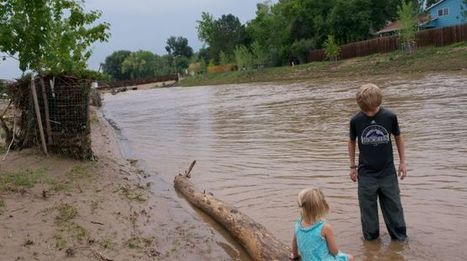 Your new post is loading...
 Your new post is loading...
We have been given a sobering glimpse into the speed of our changing climate and the vulnerabilities of our world. It turns out we must focus greater attention to the tropics, where so much of humanity and wildlife live, and to our oceans.
A sophisticated analysis, published in the premier scientific journal Nature by a team of young scientists at the University of Hawaii, Manoa, shows that impacts of climate change are already dramatic, with much more to come. While policymakers posture, dither and deny, the unraveling has already begun.
Many changes will continue in the years ahead, but we can slow them and buffer some of their impacts – if we act.
Using as a baseline the observed temperatures our world has known since 1860, when records first became reliable, biologist Camilo Mora and his co-authors sought to determine when future temperatures will move beyond the bounds of historical ranges. Others have examined how average temperatures will change; the Mora team examined how the full range of temperatures is changing, compared to historic ranges.
They come to the surprising conclusion that the tropics are particularly vulnerable. A shift out of the observed range of temperatures is expected as soon as 2020. When that happens, the coldest temperatures will be warmer than the hottest in the past. The implications for people, food supplies and biodiversity are tremendous.
Click headline to read more--
The race is on to determine which New Zealand town will win the fastest broadband speeds in the southern hemisphere in Chorus’s Welcome to Gigatown competition.
From today, Labour Day 2013, New Zealanders the world over will take to social media to tweet, like and share their views on why their favourite town should win access to 1Gbps internet services for three years.
Chorus General Manger Marketing and Sales, Victoria Crone says the race for Gigatown aims to spark innovation and mobilise the potential of ultra-fast broadband (UFB) to transform New Zealand.
“The vision for Gigatown is to create a leading digital innovation hub for New Zealand which showcases how ultra-fast broadband will re-define our economy, reshape how our children learn and change how our communities live, work and play,” says Crone.
At the end of the year-long competition, ng Connect, the open innovation program founded by Alcatel-Lucent, together with Chorus will also commit to a $200k development fund for the winning Gigatown. This fund will cover the commercialisation of new services over gigabit fibre for entrepreneurs and innovators in Gigatown, with a focus on developing new services to take to market.
To win points for their chosen town, New Zealanders will need to take to social media and champion their town’s campaign using pre-defined #Gigatown hashtags. Each piece of hash-tagged content will earn Gigapoints, as will each subsequent share, like, re-tweet or comment.
Gigatown is supported by a website that measures, displays and champions each town’s Gigatown content, and includes a leader board tallying the Gigapoints scored by competing towns.
Approximately fifty towns are pre-registered to compete, with areas of Auckland and Wellington split into “towns” within cities.
Click headline to read more--
Why doesn’t the government just get out of the way and let the private sector -- the “real revolutionaries” -- innovate? It’s rhetoric you hear everywhere, and Mariana Mazzucato wants to dispel it. In an energetic talk, she shows how the state -- which many see as a slow, hunkering behemoth -- is really one of our most exciting risk-takers and market-shapers.
Which actor in the economy is most responsible for making radical innovation happen? Mariana Mazzucato comes up with a surprising answer: the state.
Click headline to read more--
This is good news for those who visit the Rwanda Capital, Kigali. All a consumer will need is a WiFi enabled device and they will be able to browse and surf using broadband connection.
This is one of the ways Rwanda is trying to reinvent itself as a regional high tech hub by rolling out free citywide and eventually nationwide wireless connectivity.
The Rwandan government announced last month that it had started to cover the lush green, rolling hills of the capital with wireless hotspots, which is the first step of a plan to provide wifi coverage to all schools and public buildings, markets, bus stations and hotels in the city and, in the long-term, to the entire country.
The minister in charge of Information Technology, Jean Philibert Nsengimana, said he wanted to see the plan “accelerate growth of the internet sector” and attract more investors.
Click headline to read more--
Telstra chief David Thodey has admitted that structural separation of the telco is the “end game”, no matter what way the national broadband network is rolled out.
Mr Thodey has reiterated Telstra’s willingness to assume a bigger role in the building of the NBN, saying the door is “open” for negotiations with the government.
“What we have always said with the change of policy is we’re keen to help with any way we can. Obviously my responsibility is to shareholders and we’ve got to be commercially sensible. But yeah, we’re willing to consider whatever alternatives they would like to talk to us about,” Mr Thodey told Financial Review Sunday on Channel Nine.
Asked if Telstra would be prepared to build the entire network, Mr Thodey said: “I’ve often said to the minister and also to the executive there, if we can help, let us know and we will look to see if it makes commercial sense, so the door’s open.”
He said Telstra’s plan to separate its fixed line and copper network would not change under the Coalition’s NBN plan.
“When we went through those agreements part of the whole deal was we would structurally separate over time and that really meant we were willing to give up our copper access networks and being the national carrier. So whether it’s fibre-to-the-node, fibre-to-the-premise, fibre-to-the-building, it doesn’t matter the technology, the end game is still structural separation.”
Click headline to read more and watch the Channel Nine interview--
There has been recent buzz about Smart Cities, with many different definitions on what it means to be 'smart'. IDC has in fact been examining the concept of smart cities since 2010, and has had opportunity to interact with hundreds of city mayors, CIOs, government leaders involved in urban innovation, technology vendors, and IT service providers. IDC has learned that city leaders are most concerned about improving their ability to deliver efficient and relevant services across several common service domains. In terms of city infrastructure, these issues center around the provision of citizen-centric services, the expansion and improvement of transportation networks, the management of public safety, waste and energy resources, and education and health services. Economic development, tourism promotion, and job creation are also important aspects considered by city leaders.
Any Smart City initiative must therefore involve a multifaceted transformation of services and infrastructure. Such initiatives must impact numerous areas, from the provision of transport, energy, and healthcare services, to the state of public safety and government services.
"The same key questions often arise in cities as diverse as Beijing or Boston, as they consider how to grow and keep pace with technology and the expectations of their citizens and businesses," says Mukesh Chulani, Research Manager for IDC Government Insights Middle East and Africa. "Indeed, we see a similar drive towards Smarter City status by the Emirate of Dubai, where the focus is squarely on ensuring that government services are accessible and delivered quickly and efficiently. This has been the case with a wide range of government projects that can be viewed as a basis for the Smart City initiative, ranging from the Emirates Identity Authority's Population Register and the National ID Card Project (PRIDC) to DEWA's online bill payment."
Access to a vibrant city economy by business, citizens, and local government is the ultimate goal of any Smart City initiative. Effective Smart City solutions must integrate information and operations between different city systems. For example, to provide effective and smart public safety, governments would require seamless views across border management, surveillance, emergency response, and other related security systems.
What exactly, therefore, is a Smart City solution? IDC identifies the following attributes that must be included for a solution to be considered smart:
Click headline to read more--
Vera Scroggins, a retired real estate agent and nurse's aide, was in Common Pleas Court for Susquehanna County, Pa., to explain why a temporary injunction should not be issued against her.
Before her were four lawyers and several employees of Cabot Gas and Oil, who accused her of trespassing and causing irreparable harm to the company that had almost $1 billion in revenue in 2012. They didn't want her on their property they owned or leased in the Marcellus Shale.
Scroggins is an anti-fracking activist, someone who not only knows what is happening in the gas fields of northeastern Pennsylvania, but willingly devotes much of her day to helping others to see and understand the damage fracking causes. Since 2010, she had led visitors, government officials, and journalists on tours of the gas fields, to rigs and well pads, pipelines, compressor stations, and roads damaged by the heavy volume of truck traffic necessary to build and support the wells.
As part of her tours, she introduces the visitors to those affected by fracking, to the people of northeast Pennsylvania who have seen their air and water polluted, their health impacted. The visitors come from New York, which has a moratorium on fracking; from Pennsylvania, which doesn't; from surrounding states and from foreign countries, who want to see what fracking is, and what it does.
And now in a court room in Montrose, she was accused of trespassing and forced to defend herself.
Click headline to read more--
Ever since the current juggernaut of "free trade" agreements began to be negotiated under President George Herbert Walker Bush (which resulted in the signing of NAFTA under President Bill Clinton), jobs have been fleeing America as corporations have become engorged with greater profits.
There is simply no disputing this given the prima facie reality of the current configuration of the US economy. Workers in the manufacturing sector have seen their jobs and factories shipped overseas. As a result, they have become unemployed. If they are lucky enough to get a new job, it's most often at a much lower pay with fewer if any benefits. This is not true of all blue collar workers, but it's the accelerating trend.
Truthout/BuzzFlash staffers are members of the the Newspaper Guild of the Communication Workers of America (CWA), and so issues affecting workers are personally important to us.
Congressman Alan Grayson (D-FL) calls what is known of the framework of the secretively negotiated Trans-Pacific Partnership (TPP) "a punch in the face to the middle class." Larry Cohen, CWA president, adds that the TPP represents "a race to the bottom and we need a race to the top":
Click headline to read more--
An earthquake of magnitude 7.3 struck early Saturday off Japan’s east coast, the U.S. Geological Survey said, triggering small tsunamis but causing no apparent damage.
Japan’s meteorological agency said the quake was an aftershock of the magnitude 9.0 earthquake and tsunami that struck the same area in 2011, killing about 19,000 people and devastating the Fukushima Dai-Ichi nuclear power plant.
Tsunamis of up to 40 centimeters (15 inches) were reported Saturday at four areas along the coast, but a tsunami advisory was lifted less than two hours after the quake.
Japanese television images of harbors showed calm waters. The quake hit at 2:10 a.m. Tokyo time (1710 GMT) about 290 kilometers (170 miles) off Fukushima, and it was felt in Tokyo, some 300 miles (480 kilometers) away.
“It was fairly big, and rattled quite a bit, but nothing fell to the floor or broke. We’ve had quakes of this magnitude before,” Satoshi Mizuno, an official with the Fukushima prefectural government’s disaster management department, told The Associated Press by phone. “Luckily, the quake’s center was very far off the coast.”
Mizuno said the operator of the troubled Fukushima plant, Tokyo Electric Power Co., said no damage or abnormalities have been found.
Click headline to read more--
Your smartphone is your most portable computer. It’s also a treasure trove of personal information. You wouldn’t leave your laptop unlocked in public, so why leave your phone unprotected? Lock up that data and encrypt it.
Social media, budgeting and finance apps, photos, address book, and email — they’re all filled with details about you and the people you know. Yet for some reason a third of smartphone users in the U.S. still don’t bother setting up password security on their phones. It’s a shame because using a four-digit pin or a pattern lock is one of the easiest ways to keep thieves out of your phone. Trust us, the person that finds your phone in the back of a cab or swipes it from your open bag while you’re on the bus isn’t a criminal mastermind. On the other hand, they will be able to figure out from your emails when you’ll be on vacation and what time you leave for work.
FCC officials said that in 2012 smartphone theft increased from 8 percent to 42 percent in New York City over a 10 year period. The agency suggested a system where you call your carrier to brick your phone as soon as its stolen to reduce identity theft. But most people who lose their smartphones spend at least some time retracing their steps in the hopes of, you know, finding it. In fact, having your carrier enable such a scorched earth protocol kind of renders tracking services like Apple’s ‘Find My iPhone,’ obsolete.
If your phone does fall into the hands of the smarter-than-average thief, encrypting the contents will add an extra level of security that could mean the difference between a minor inconvenience and dealing with various agencies trying to restore your identity. Android’s encryption feature requires a passcode entered into the phone every time it’s powered back on. It can also protect any SD cards you use with your Android phone. To turn on encryption, navigate to Settings > Security. The only downside is that whenever you do turn on your phone with encryption, it’ll take an hour to decipher all your information.
Click headline to read more--
In this 17-minute TED talk, Jeff Speck, a city planner and architectural designer, discusses the unsustainable American car culture, saying that we need to transition to walkable cities.
He explains that we’ve gone from spending one-tenth of our family incomes in the 70′s to one-fifth today for our auto transportation and we’ve also doubled our roads since then. Working families are spending more on transportation than housing, because they’re driving long distances to the house they want, that they are able to afford. Also, in the 70′s, one-tenth of our population was obese, and now it is one-third, while a second one-third of our population is now classified as overweight.
Speck believes that our American healthcare crisis is an urban design crisis, but that urban design can be the cure. “Inactivity is born of our landscape,” he says.
The attitude is changing to one of healthful living in cities, whereas in the past, it was assumed that cities were the unhealthy place to live.
While this talk is not specifically related to agriculture, it does relate to a changing value system towards sustainable living, and all trends in lifestyle impact the food system in one way or another, including distribution, urban gardening, vertical gardening, farm-to-table, and eat-local production surrounding urban centers.
Incidentally, here in Colorado, the number of residents locating to a rapidly evolving downtown Denver has increased by 140 percent since the year 2000.
Click headline to watch the video of the TEDTalk--
Readers of Glenn Beck’s email list received a sponsored message from a source that might surprise some: a solar generator vendor. Solutions From Science sells heirloom seeds, emergency food, and solar products designed to “make people more self-reliant,” according to the Clinton Herald.
Bill Heid, the company’s president, wrote in the email that solar generators are great in emergencies, “run quietly, emit no dangerous fumes, and produce free electricity from the sun.” The email throws in a special deal for Beck’s readers after it makes the case for preparing to live off the grid:
"And whether it’s hurricanes, ice storms, brownouts, or blackouts… with a Solar Generator, you won’t have to worry about painful power outages ever again. As I’m writing this, there are power outages in the news from wild fires, wind, flooding, heavy snow, copper thieves, cars hitting power poles and even an explosion on one college campus. Many experts are even saying the whole grid is going down."
A solar-powered generator that allows consumers to get clean power during emergencies like wildfires, high winds, flooding, brownouts, and blackouts (among the other more apocalyptic scenarios), being sold under Glenn Beck’s name.
The name of the company and the products it advertises could lead people to believe it was just in the business of taking what top climate scientists say, going back to nature, getting off the grid, becoming energy-independent, and freeing its customers from reliance on carbon-based fuels and large agricultural corporations.
Until you get to the About Us page: Click headline to read more--
There aren't many upsides to Snowden's revelations that NSA is essentially spying on the entire Internet, all the time, but if one good thing has already come out of that sorry state of affairs it's the emergence of security expert Bruce Schneier as a mainstream commentator on the digital world. That's largely because his core expertise has been shoved into the very center of our concerns, making his thoughts on what's going on particularly valuable.
One fruitful theme that he has been developing recently is the idea of feudal computing (I imagine it could well turn out to be the subject of his next book.) Schneier first wrote about this even before the NSA story broke, back in November last year. He then revisited the idea shortly after the first Snowden story appeared, and has now returned to the theme again, in what is perhaps his best essay on the subject so far. It's called "Power in the Age of the Feudal Internet," and explores some of the implications of our new digital dystopia -- and what we can do about it. It begins by describing how things were supposed to be:
Click headline to read more--
|
Australian fixed line incumbent Telstra, in partnership with French-US vendor Alcatel-Lucent, has achieved speeds of up to 100Mbps over its existing copper networks, The Australian reports.
The development comes after the two companies began trials of vectoring technology last month, with a view to showcasing Telstra’s credentials as a potential construction partner for the National Broadband Network (NBN) project.
Web users are vulnerable to mass online spying because the US has too much power online, according to a leading security researcher.
Discussing revelations of US spying at his LinuxCon keynote speech, F-Secure’s chief research officer Mikko Hypponen argued that US dominance over the internet had come at the expense of democracy.
Hypponen quoted Tenable's chief security officer, Marcus Ranum, who has previously described the internet as "a US colony".
"We’re back in the age of colonisation," said Hypponen. "We should think about the Americans as our masters."
Hypponen’s comments come as a debate rages over the merits of mass spying versus the right to privacy, following the revelations by whistleblower Edward Snowden.
Hypponen gave a point-by-point attack against assertions that online spying was necessary, arguing that its dominance over the web gave the US too much power over foreign countries.
He claimed that while the majority of European politicians likely use US services every day, most US politicians and business leaders don’t, for example, use Swedish-based cloud services. "It’s an imbalanced situation," he said. "All the major services are based in the US."
Click headline to read more--
We’re in the middle of an epic battle for power in cyberspace. On one side are the traditional, organized, institutional powers such as governments and large multinational corporations. On the other are the distributed and nimble: grassroots movements, dissident groups, hackers, and criminals. Initially, the Internet empowered the second side. It gave them a place to coordinate and communicate efficiently, and made them seem unbeatable. But now, the more traditional institutional powers are winning, and winning big. How these two side fare in the long term, and the fate of the rest of us who don’t fall into either group, is an open question—and one vitally important to the future of the Internet.
In the Internet’s early days, there was a lot of talk about its “natural laws”—how it would upend traditional power blocks, empower the masses, and spread freedom throughout the world. The international nature of the Internet bypassed circumvented national laws. Anonymity was easy. Censorship was impossible. Police were clueless about cybercrime. And bigger changes seemed inevitable. Digital cash would undermine national sovereignty. Citizen journalism would topple traditional media, corporate PR, and political parties. Easy digital copying would destroy the traditional movie and music industries. Web marketing would allow even the smallest companies to compete against corporate giants. It really would be a new world order.
This was a utopian vision, but some of it did come to pass. Internet marketing has transformed commerce. The entertainment industries have been transformed by things like MySpace and YouTube, and are now more open to outsiders. Mass media has changed dramatically, and some of the most influential people in the media have come from the blogging world. There are new ways to organize politically and run elections. Crowdfunding has made tens of thousands of projects possible to finance, and crowdsourcing made more types of projects possible. Facebook and Twitter really did help topple governments.
But that is just one side of the Internet’s disruptive character. The Internet has emboldened traditional power as well.
Click headline to read more--
Deepwater Horizon exploded off the Gulf of Mexico, claiming 11 lives, followed by an estimated 200 million gallons of oil that polluted the sea and shores with black poisonous tar for three months. The world’s worst oil catastrophe in history left the Gulf’s fishing and tourist industries in an extremely depressing situation. It’s not exactly accurate to claim that life on the Gulf is completely dead. The oil industry is booming. But thanks primarily to British Petroleum’s and Halliburton’s decisions of gross negligence i.e. putting profits first over safety, the tourist and fishing industries are struggling to say the least, (read Dahr Jamail’s Gulf Ecosystem in Crisis) which is the reason BP was forced to set aside a relief fund of $20 billion dollars for victims of these Gulf businesses; some did well from the settlements, but many are in dire straits. Moreover, BP is still sitting on most of that relief fund money.
Cleanup has been an ongoing nightmare. Scientists are now concerned about the possibility of restoration given the damage that was done to the fragile ecosystems, specifically the food chain that has been “dissolved” from harsh chemical pollutants: viz. the combination of oil and the potent toxic dispersant Corexit. Corexit is largely the culprit that has literally dissolved the food chain vital for regeneration of marine life.
Click headline to read more--
Much like the Google News homepage, YouTube’s news channel aggregates video news content from some of the biggest – and smallest – broadcasters on earth. Also, like Google News, the channel does not actually produce its own journalism. The YouTube news channel has more than 21 million subscribers and, as of last week, a new global head of news, Tom Sly.
Most recently director of development for Google Fiber, Sly spoke with Digiday about what success looks like for YouTube News, why it doesn’t do its own journalism, and what the future holds for mobile. Excerpts:
Click headline to read the interview--
The worst storm in five years is forecast to hit England and Wales on Sunday night, bringing heavy rain, high winds and the threat of flooding and travel chaos.
Winds of more than 80mph could leave a trail of destruction across large parts of the UK, knocking down trees and causing major structural damage and power cuts.
The storm, named after St Jude – the patron saint of lost causes whose feast day is on Monday – will develop over the Atlantic and is expected to hit the south-west late on Sunday, before moving north-east across England and southern Wales.
David Cameron said he had spoken to the organisations responsible for public safety during the storm. The prime minister wrote on Twitter: "I've just chaired a call with various government departments and agencies to hear about all the plans to ensure people are protected from tonight's storm."
The weather system is expected to have moved out over the North Sea by Monday lunchtime, leaving strong breezes in its wake.
With the Met Office predicting that 20-40mm of rain could fall within six to nine hours overnight, insurance companies are advising households to protect themselves and their property.
People should also establish evacuation plans, place valuable items upstairs to limit flood damage and ensure gutters are clear so water can drain away.
The Met Office – which has issued an amber warning advising the southern half of England and the southern half of Wales to "be prepared" – described the storm as not one "you would see every year".
Click headline to read more--
North Dakota, the nation's No2 oil producer behind Texas, recorded nearly 300 oil pipeline spills in less than two years, state documents show. None was reported to the public, officials said.
According to records obtained by the Associated Press, the pipeline spills, many of them small, are among some 750 "oil field incidents" that have occurred since January 2012 without public notification.
"That's news to us," said Don Morrison, director of the Dakota Resource Council, an environmental-minded landowner group with more than 700 members in North Dakota.
Dennis Fewless, director of water quality for the state Health Department, said regulators are reviewing the state's policies for when to publicly report such incidents after a massive spill was discovered last month in northwestern north Dakota by a wheat farmer. State and company officials kept it quiet for 11 days — and only said something after the AP asked about it.
North Dakota regulators, like in many other oil-producing states, are not obliged to tell the public about oil spills under state law. But in a state that's producing a million barrels a day and saw nearly 2,500 miles of new pipelines last year, many believe the risk of spills will increase, posing a bigger threat to farmland and water.
"We're certainly looking at that now and what would be a threshold for reporting to the public," Fewless said. Taking notice of the recent criticism, the state issued a statement 17 October on an estimated seven-barrel oil spill in Divide County, which borders Canada in far northwestern North Dakota.
The state also is mulling a better system to track spills in-house, Fewless said, from their origin to cleanup status.
"We really have to dig through our data base to get specifics," said Fewless, adding that a more user-friendly tracking system for regulators may be developed.
Click headline to read more--
Just a few weeks ago, attorneys for the No on 522 campaign were feeling rather smug when a lawsuit filed against them by a group called “Moms for Labeling” was dismissed. As I wrote last week, consumer class action attorney Knoll Lowney sued the No on 522 and the Washington DC-based Grocery Manufactures Association (lobbyists for major food corporations) for not disclosing the donors behind GMA’s $7 million-plus donations to stop I-522, which would require genetically-engineered foods to be labeled. The judge threw out that case on a technicality.
But then, Big Food’s arrogance got the best of them.
Last Wednesday, Washington State Attorney General Bob Ferguson picked up where the Moms for Labeling lawyer left off by filing his own complaint, which adds stunning detail to the allegations in the original suit. In case you’re not familiar with what the attorney general does, he or she is the state’s top law enforcer, but often has limited resources to act. So when the AG’s office decides to come after you, it’s a very big deal, far bigger than a private attorney doing so.
The new lawsuit also accuses GMA of violating the state’s campaign disclosure laws, and alleges that the trade group secretly gathered more than $7 million from its members. Not content to just collect food industry money illegally, or even discreetly, GMA had the chutzpah to a designate a special account dubbed the “Defense of Brand Strategic Account,” for a strategic, “multi-pronged approach” to fight labeling laws, including Washington’s I-522.
And this scheme didn’t just pop up recently either; rather the shady deal-making was in the works for months, soon after the narrow loss of Proposition 37 in California. The plan was hatched at a GMA board meeting this past January to fund future anti-labeling efforts with “a preference for GMA to be the funder of such efforts, rather than individual companies.” That’s because brand names like PepsiCo and General Mills took a lot of heat from upset consumers. So, as GMA CEO Pamela G. Bailey explained in a February memorandum, a plan to “better shield individual companies from attack” was quickly approved; GMA sent its first round of invoices to members by March and the second round went out in August.
The dollar figures are staggering:
Click headline to read more--
The federal Environmental Protection Agency has awarded $65,000 to help Gary expand its use of green infrastructure to reduce water pollution and while increasing economic activity and neighborhood revitalization.
Green infrastructure tools and techniques include green roofs, permeable materials and alternative designs for streets and buildings. The EPA says the funding announcement Friday is in support of President Barack Obama's Climate Action Plan to reduce carbon pollution and address the impacts of climate change.
Funding will help develop strategies to meet water quality goals. The EPA assistance may also help develop a green infrastructure jobs training program in Gary.
In the last two years, EPA has provided $1.35 million to more than 20 communities for green infrastructure.
This is a national emergency.
As I walked through the neighborhoods in Boulder, Colorado several weeks ago, navigating streets that had first become creeks and then rivers, the reality of climate change truly hit home. The devastation Americans saw on the news was a true reflection of what was happening on the ground. Though I am grateful that the storm has passed, the vulnerability remains.
Just as scary as bearing witness to such a massive loss of life and livelihood is knowing that it could happen again. Of course, it took an extraordinary convergence of events -- with moisture feeding into the storm system from both the Pacific and the Gulf of Mexico coupled with an erratic Jetstream creating blocking patterns over the Rockies -- to make this seven-day tropical storm of truly biblical proportions possible. But these days the extraordinary is quickly becoming the everyday, and there's no reason to think it couldn't happen again.
Although scientists are quick to tell us that such singular weather events are not directly caused by climate change, we know the increasing greenhouse gases in the atmosphere traps more and more heat. The effect is warmer oceans, more moisture in the air--the list could go on and on--that together disrupt established weather patterns and intensify what our climate already has in store.
The net effect is wide-ranging damage and disruption that goes well beyond Colorado's one-in-a-thousand year rains or the devastation left by hurricanes, wildfires and drought.
When droughts stretch on for years--as they have recently in the American Midwest--the agricultural sector struggles, and consumers feel it at the grocery store checkout. Increasing ocean temperatures and acidity decimate certain fish populations, affecting subsistence fishermen and large commercial operations alike.
Click headline to read more--
The road to an efficient broadband service in Nigeria has been a long and arduous one. Indeed, internet connectivity has come a long way from a single international submarine cable system with 340 GB total capacity installed in 2001 (SAT3) to a total of four cable systems with international bandwidth capacity of over nine Terra bits by 2012. Despite the progress that has been made, Nigeria is still a far cry from achieving what is considered global broadband standards even among other developing countries. The Internet access market is still characterised by the slow and exasperating access to the cyberspace. There have been many bottlenecks to the provision of effective broadband service in the country ranging from Infrastructural challenges to regulation and capacity issues. As at 2012, Nigeria’s broadband penetration rate was put unofficially at 6 percent, which means the country is seeking to achieve 30 percent penetration by the end of 2017. But why is the development of broadband so critical to Nigeria? The reasons are not far-fetched. Internet and broadband have been globally acknowledged as the foundation for the nation’s transformation to a knowledge-based economy. It is also widely acknowledged that broadband infrastructure is an enabler for economic and social growth of the economy. World Bank studies show, that in low and middle –income countries, every 10 percent point increase in broadband penetration accelerates economic growth by 1.38 percentage points. Globally, nations both developed and developing are making elaborate plans to ensure access to broadband internet to its citizens with various countries coming up with broadband plans to address their peculiar broadband needs. Click headline to read more--
Information and communications technology (ICT) players are happy that the Government is improving Internet coverage and speed in both urban and rural areas.
Multimedia Development Corporation Bhd (MDeC) chief executive officer Datuk Badlisham Ghazali said the announcements were a big boost to digital Malaysia and would serve as an important catalyst to drive the country towards a digital economy.
“The more people and businesses go online, the quicker we as a country can drive our levels of production, efficiency and ultimately, improve the quality of life of our people,” he said.
He added that expanding Internet access in schools, particularly in the rural areas, was a critical factor in empowering households earning below RM2,300 which make up some 40% of Malaysian households.
National ICT Association of Malaysia (Pikom) chairman Woon Tai Hai said more effort needed to be put in to encourage a higher take-up rate among those living in rural areas.
“The take-up rate of the Internet in rural areas also depends on economic growth and the digital lifestyle of that community. Setting up the infrastructure is only the first step,” he said.
Click headline to read more--
|



 Your new post is loading...
Your new post is loading...






























